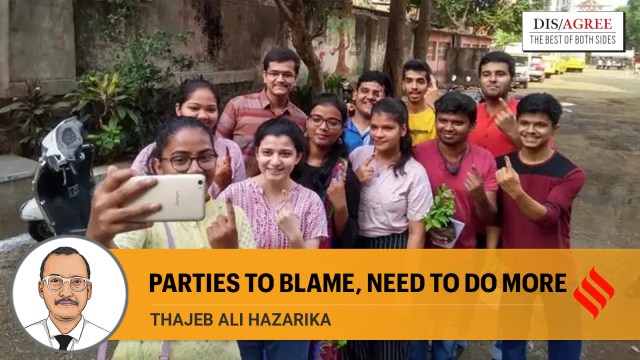
Alarm bells start ringing when the world’s biggest festival of democracy has very few young people proudly flashing an index finger marked with indelible ink — the booster shot to consolidate, nurture, and reaffirm Indian democracy. The early phases of polling this year had a low turnout, including from the youth, the future of the country and the main catchment source of political support of every political party. There needs to be honest introspection on what is holding Gen Z back from participating in the electoral process.
The number of young voters in the age group of 18 to 19 years in 2014 was 15 million compared to the present 18 million. It needs to be understood that the difference of this three million in terms of political participation, including the sacrosanct duty to cast the vote, will be vital. Much of the onus for mobilising this segment lies with political parties. Political socialisation and recruitments are crucial for parties to enhance and consolidate their base. Grassroot-level organisations and affiliated student wings have always been active in inducting young blood in political parties. The question to be asked here is which of these student-led organisations have a head start. The ABVP, NSUI, SFI, among others, are keen to consolidate their influence. Many of the youngsters who join these parties enlist for university elections, from where young leaders emerge. Later, such leaders naturally move on to mainstream national parties in various capacities.
As their aspirations to go up the ladder surface, the face-off with seasoned veterans inside the party comes as a stumbling block for the young Turks. Most parties are unwilling to change the status quo, leading to these young aspirants feeling increasingly lost and isolated. Many jump ship, others are disillusioned enough to move out of active politics altogether, becoming independent analysts, among other things. Their prospects also discourage other youngsters from joining in college politics.
Another important factor in the low youth involvement is how parties mobilise social media. The way news is consumed has changed radically. Studies show that the youth turn to Instagram, YouTube, Twitter and Facebook for their political education. It is, therefore, also a test for political parties to see how they use these platforms to encourage the youth to ward off their lethargy and indifference.
The election of 2014 was a game changer for the BJP, which successfully managed to do this, aided by the charisma of Prime Minister Narendra Modi which created a political tsunami. The next election, in 2019, was no different and the wave continued. The BJP’s focus on developing a youth connect yielded rich dividends, making it one of the top priorities for the party this year as well. Some of their beneficiaries remain loyal, especially young women. Not to be left behind, the Congress has attempted the same with the Bharat Jodo Yatras. There is a personal equation factor with the leader that matters here. The crowds, the selfies are all favourable indicators, but the question to be asked here is this: Does the crowd at a roadshow translate into actual votes or is it merely the curiosity factor that draws people in to see leaders and star campaigners? After all, veteran leaders, too, attract crowds.
In such a scenario, it is interesting to know the young cadre strength of each of the competing parties because this is what will indicate, in real terms, whether the crowd during the mega roadshow could translate into votes.
Among the issues raised in this election are the core ones of unemployment, poverty, corruption and social security. These are issues that affect the youth at every level. When you are worried about getting or keeping a job, can you afford to take the time out to go vote? Think of a situation where a migrant from the north of the country working in a spice factory down south has to undertake a journey of anything between 24 to 72 hours to cast his vote. Even if he gets a day off with paid leave, would he undertake the journey? Would his tired question not be if it is “worth” it? Just as the outreach to youngsters has to be stronger, there should also be feasible alternative arrangements to encourage the youth to vote. Postal ballot is a possible answer. The ECI’s efforts to make arrangements for home ballots, to facilitate voting by the sick and the elderly, is laudable. A sympathetic ear to the plight of the young would go a long way towards encouraging their participation.
The writer is a teacher at The Assam Valley School


